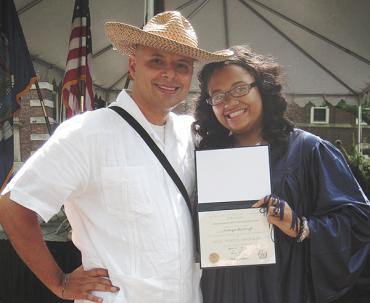Mauricio Gonzalez
Teacher
Urban Assembly New York Harbor School
“When will I ever use this? And why am I even here?”
Many teachers hear these questions from their students—and sometimes wonder how to answer. Because when overtesting and a standardized curriculum create an irrelevant, artificial environment in the classroom, students and teachers alike lose contact with the real-world relevance of school.
Not so in career and technical education.
I teach biology and marine biology at the New York Harbor School, where high school kids learn practical skills that will make them ready for work or college. They practice hands-on lab techniques and gain field-specific knowledge, but they also become respectful learners, dependable workers, critical thinkers and independent problem solvers, with skills that will serve them wherever they go after graduation. Career and technical education is not just about real-world development—it’s also about character development.
This is not the “voc-ed” of yesteryear, when low-income kids were tracked into wood shop and typing. CTE is an enhanced version of what all secondary education should be. It’s a great opportunity for students to focus on a practical way to make a living. The programs at the Harbor School give students constructive pathways to jobs where they will earn more than minimum wage. They stay in school because they know it will help them climb the ladder of opportunity. They get it: They can actually make money with the skills they’re learning, and they can make a real difference in the world around them.
For example, our students are learning about the impact of marine construction on biodiversity in the Hudson River. This is their home, their river, a place they see every day. They’ve learned that concrete can harm the flora and fauna in the water, so they are conducting experiments to find a mixture of concrete and cement that will help protect marine life. We’ve created a voluntary citizen science team called the Harbor SEALs that monitors the water quality of the Hudson River Estuary year-round. And our students are redesigning Manhattan’s edge to promote a healthier environment for marine species and residents.
When students are exposed to these real-world problems, when they find out they’re scheduled to Skype with a scientist who lives in Israel to analyze data with him, they have to step up. They have to communicate properly, be punctual and write a professional report, and they understand that their work is valued by other people. Most important, because they feel valued, it keeps them engaged.
Our research program is a pipeline to real careers in science, technology, engineering and math, and we maintain a graduation and college attendance rate of over 90 percent.
Our secondary schools risk failure due to a preoccupation with controlling and testing, rather than educating, our kids. Independent thinking, problem solving, creativity and responsibility have been systematically removed from the public school curriculum. Bringing back these ideas in the form of career and technical education is one of the most powerful ways to address the crisis we’re facing.
I believe in CTE because it lifts up underrepresented kids and gives them a chance to rise above the poverty line. It evens out the playing field, makes middle-class jobs not only more understandable, but more democratically accessible to the common Joe on the street. And that’s something worth fighting for.
Mauricio Gonzalez began his career in conservation research and became a teacher in 2001. He teaches at the Urban Assembly New York Harbor School, where he has developed a science research program for students interested in immersing themselves in field work. Gonzalez has seen the powerful impact this hands-on learning can have on his students, and is a true advocate for career and technical education. He says his students not only learn practical skills, they practice taking their work—and, by extension, their education—very seriously.

